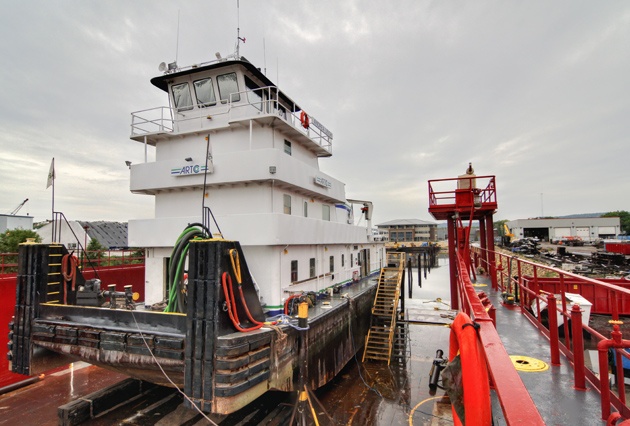Usual Concerns That Bring About Pricey Dock Repairs
Usual Concerns That Bring About Pricey Dock Repairs
Blog Article
Efficient Dock Repair Service Techniques: Making Sure Architectural Stability
Making sure the structural honesty of docks via efficient repair work methods is paramount for the longevity and safety of marine centers. Consequently, selecting the right fixing materials, such as composite products and corrosion-resistant alloys, is crucial for resilience.
Evaluating Dock Damage
Examining dock damages is a vital first action in ensuring the architectural honesty and safety of any kind of docking center. Key elements to check out include the dock's structure, pilings, decking, and equipment (Dock Repairs).
Architectural engineers or certified assessors normally perform these assessments using specialized tools and methods. Underwater assessments may employ sonar equipment or from another location operated automobiles (ROVs) to find submerged damage. Above water, aesthetic assessments are matched by utilizing moisture meters and various other analysis tools to reveal underlying problems not right away visible to the nude eye.

Picking Repair Service Products
Selecting the suitable repair work materials is a critical step in the dock remediation process, one that directly affects the long life and performance of the repaired structure. Product choice should be driven by factors such as ecological conditions, load-bearing needs, and compatibility with existing dock elements.
In addition to timber, composite materials are increasingly preferred because of their sturdiness and low upkeep requirements. Compounds, normally made from a mix of plastic and wood fibers, supply exceptional resistance to rot, insects, and UV damages. For metal docks, picking corrosion-resistant alloys such as galvanized steel or marine-grade aluminum is necessary to protect against corrosion and make sure structural integrity in saline water problems.
Epoxy resins and marine-grade sealers are important for repairing fractures and securing joints, providing a water resistant obstacle and enhancing the dock's general toughness. By carefully picking premium products, dock repair work can attain lasting outcomes, thereby securing versus future degradation and making sure safe, trusted use.
Structural Reinforcement Strategies
Effective architectural support techniques are vital in making certain the stability and durability of dock fixings. One fundamental technique includes using steel or composite reinforcement bars (rebar) within concrete frameworks. Rebar supplies added tensile strength, avoiding fractures and dispersing lots extra evenly. This method is especially efficient for docks subjected to hefty loads or harsh ecological conditions.
An additional necessary method is the application of fiber-reinforced polymers (FRP) These materials offer high strength-to-weight proportions and exceptional resistance to rust, making them perfect for reinforcing concrete or wood docks. FRP can be used in sheets or strips and bound with epoxy resins to enhance architectural stability.
Bracing and securing systems likewise play a vital role in architectural support. Cross-bracing, using steel or wood light beams, can combat lateral forces, reducing guiding and motion. Anchoring systems, such as helical piers or driven heaps, give a steady foundation by transferring lots to deeper, more secure soil layers.
Last but not least, the combination of load-distribution plates can help disperse weight more equally across the dock's surface area, alleviating localized stress and anxiety points. These strategies collectively ensure that anchors stay safe and durable, qualified of standing up to the roughness of their functional atmosphere.
Advanced Repair Work Methods

An additional innovative strategy entails undersea welding, which enables fixings to be performed without the demand to dewater the location. This technique is especially helpful for attending to architectural problems in submerged dock components, ensuring minimal disturbance to procedures. Boosted welding methods, combined with robotic systems, deliver accuracy and integrity, therefore expanding the life-span of the dock.
In addition, cathodic protection systems are implemented to avoid corrosion in metal dock structures. By using sacrificial anodes or amazed current systems, these techniques effectively mitigate the electrochemical procedures that bring about product deterioration.
Last but not least, advanced monitoring modern technologies, such as structural health surveillance (SHM) systems, supply real-time data on the condition of dock frameworks. These systems make it possible for positive maintenance and prompt treatments, eventually ensuring the long-lasting architectural stability of the dock.
Upkeep and Avoidance
Maintenance and avoidance are fundamental principles that underpin the durability and safety and security of dock frameworks. Regular examinations are vital, enabling very early detection of damage, prospective weaknesses, and ecological effects. An aggressive technique, including routine checks for deterioration, rot, and structural changes, alleviates costly fixings and extends the dock's operational life.
Precautionary measures must include using protective coatings to steel components to guard versus rust and making use of treated timber to withstand decay. Furthermore, guaranteeing proper water drainage and air flow can stop water build-up, which is a common reason for architectural deterioration. Incorporating top quality materials and adhering to manufacturer standards during building and construction and fixing phases likewise play vital roles in enhancing longevity.

Training personnel in dock maintenance finest methods makes certain regular application of preventive steps. Leveraging technological breakthroughs, such as drones for evaluations and sensors for real-time monitoring, can better boost maintenance initiatives. By prioritizing upkeep and prevention, dock owners can make sure architectural integrity, functional safety, and cost-effective administration check this over the dock's lifespan.
Verdict
In verdict, preserving the architectural stability of marine centers requires thorough dock repair service techniques. Advanced fixing techniques, coupled with regular upkeep methods, guarantee the dock continues to be operational and risk-free under varied environmental problems.
Making sure the architectural honesty of docks via efficient fixing techniques is vital for the longevity and safety and security of aquatic centers.Selecting the ideal repair service products is a pivotal action in the dock reconstruction process, one that directly affects the longevity and performance of the repaired structure.Efficient architectural support strategies are crucial in making sure the security and durability of dock repair services. By focusing on upkeep and avoidance, dock proprietors can make certain structural integrity, operational security, and economical monitoring over the dock's lifespan.
In conclusion, keeping the architectural honesty of aquatic centers demands thorough dock fixing strategies.
Report this page